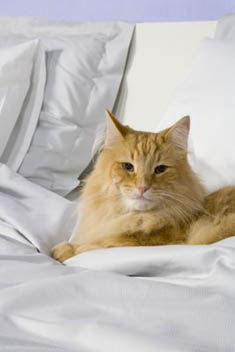Diagnosis of Feline Hyperthyroidism
Diagnosis of hyperthyroidism is based on history, physical examination and blood tests supported by other diagnostic procedures.
Routine Blood Tests
The following blood results, along with the clinical signs discussed, should prompt further tests of thyroid function:
- Erythrocytosis
- Increased packed cell volume, red blood cell count and hemoglobin concentration
- Rarely – anemia, usually in severe cases
- Altered white blood cell counts
- Mature neutrophilia
- Lymphopenia or lymphocytosis
- Eosinopenia or eosinophilia
- Mild to marked increases in liver enzyme activity
- alanine aminotransferase (ALT), alkaline phosphatase (AP),aspartate aminotransferase (AST) and lactate dehydrogenase (LDH)
- Mild to moderate increase in urea and creatinine
Thyroid hormone assay
The most reliable test for confirming hyperthyroidism is demonstration of an elevated serum total T4 (TT4) and/or free T4 (fT4) concentration.
Cats with concurrent diseases and those in the early stages of hyperthyroidism may have thyroid hormone levels within the reference range. Moreover, there are significant daily variations in TT4 concentrations meaning that levels in a single sample may be within the reference range even in a hyperthyroid cat. If hyperthyroidism is suspected based on clinical signs, TT4 should be retested in 1 week. If TT4 is still within the reference range, other diagnostic tests should be considered.
Other Tests
- Free T4 by equilibrium dialysis
- Thyroid imaging – important in detecting ectopic thyroid tissue (not uncommon).
- Scintigraphy – abnormal glands have increased uptake of iodine and can be clearly identified. A gamma camera is required.
- Ultrasound – limited use.
- Absence of TT4 suppression by exogenous T3 – after measurement of basal TT4, T3 is injected repeatedly over a 2-day period and TT4 levels measured again. In normal cats TT4 is suppressed by 30-50%, whereas little supression is seen in hyperthyroid cats.
- Thyroid stimulation tests – in normal cats administration of thyroid stimulating hormone (TSH) or thyrotropin releasing hormone (TRH) increases TT4, but this response is blunted in hyperthyroid cats. TRH is more readily available and the test is more sensitive.


